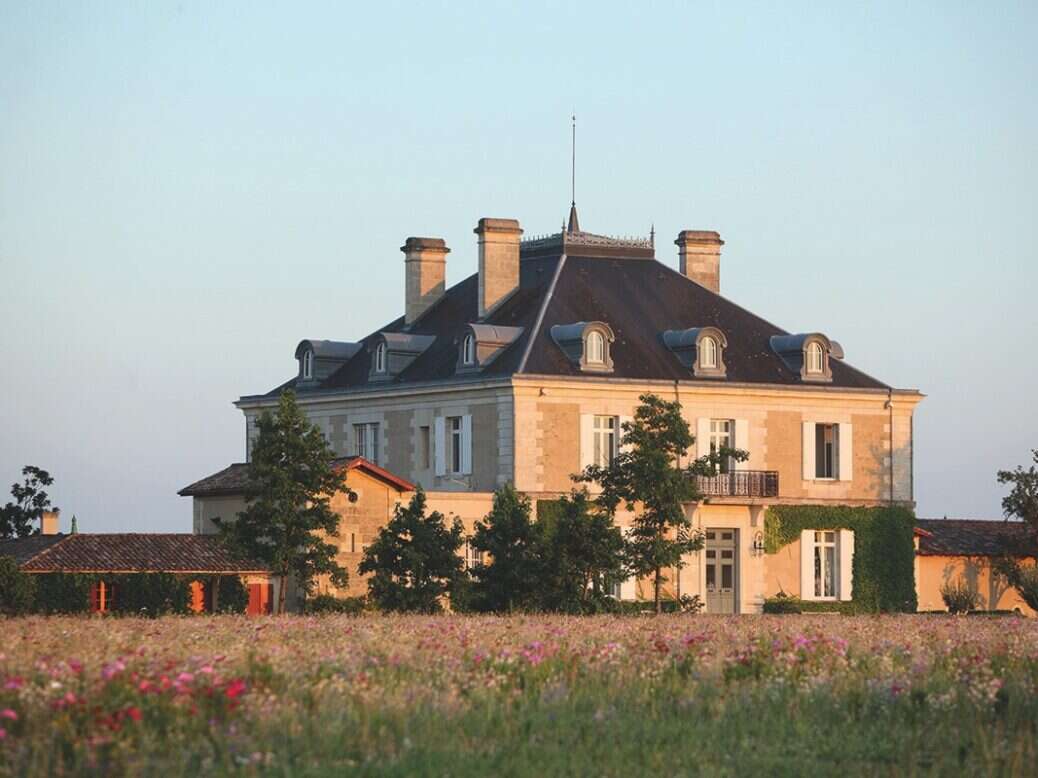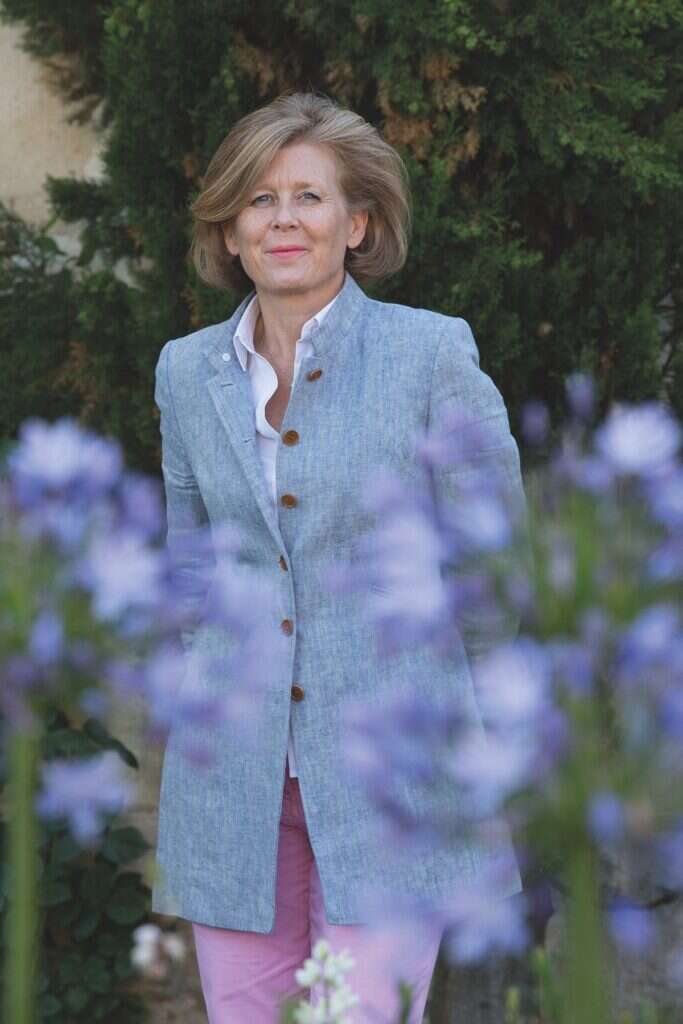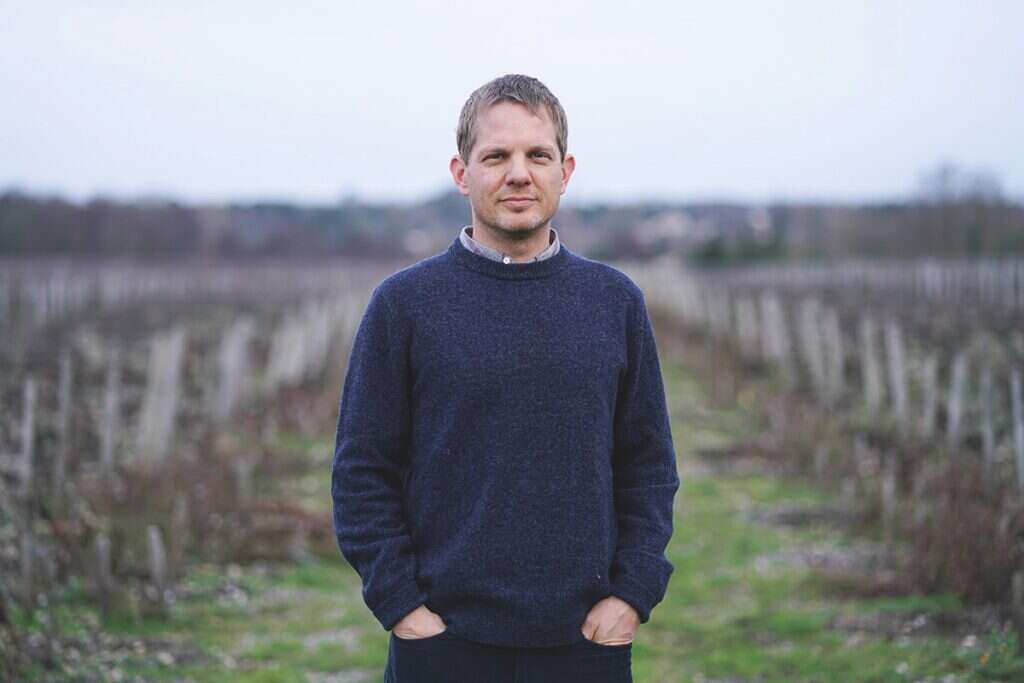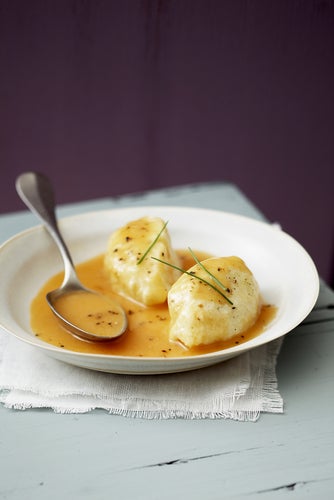
With Bordeaux in the midst of the 2022 en primeur campaign, we are posting online for the first time some of our favorite pieces on the region, its producers, and their wines from past issues of The World of Fine Wine. First published in WFW64 in June, 2019, Harry Eyres profiled Château Haut-Bailly and told the story of how the charming but steely Véronique Sanders has restored the historic Pessac-Léognan estate to its rightful reputation.
Many praise the charm of Véronique Sanders, but fewer perhaps emphasize the steel, determination, and intelligence that have made her tenure of what was once her family property one of the most successful in Haut-Bailly’s illustrious history. If a château that in the mid-20th century flew under the radar now shines bright in the Bordeaux firmament, the credit is due to this deceptively demure, fair-haired, blue-eyed director and the singularly fruitful relationship she enjoyed with the late owner, the American banker Bob Wilmers, and now maintains with his son Chris.
The history of Haut-Bailly runs in her blood and is almost an obsession with her. We meet in cool downstairs offices where there is little decoration except a series of maps showing the extent and makeup of this distinguished Pessac-Léognan (formerly Graves) grand cru over the centuries. They are not grand—nothing at Haut-Bailly is grand—but they make a powerful point in a quiet way (the house style again). The point is an extraordinary consistency in the vineyard holding, over at least four centuries, since the time (1630s) when the property was acquired and given its name by the Parisian banker Firmin Le Bailly, and likely much earlier.
An exceptionally blessed terroir
The 33ha (82-acre) vineyard at Haut-Bailly, rather unusually for a top Bordeaux wine, consists of a single contiguous block (30ha [74 acres] are under vine). It occupies a high, sandy, gravelly croupe—well, high for this low-lying countryside—which in fact is the most elevated point of the entire Pessac-Léognan appellation, at a dizzying 158ft (48m) of altitude. Drainage here is exceptionally good, frost rare, and the high exposed position means there is plenty of sunshine, and wind to keep fungal diseases at bay. The rather foursquare, unpretentious château itself (deceptive again, since it seems far larger on the inside than the outside) stands at the top of the croupe and right next to the vines.
It is to the vines that Sanders immediately directs me, on a day of beautiful early spring sunshine; it is the first week of March, and the previous week, in late February, the thermometer had touched an improbable 82°F (28°C). Or rather, she directs me to one particular vine, of venerable age and wonderfully gnarled appearance. This grandfather or grandmother plant is a Petit Verdot vine planted, she reckons, around 125 years ago. This is part of a 4ha (10-acre) block of extremely old vines close to the château building that forms the nucleus of the vineyard.
Despite some reports, she says these vines are “probably not pre-phylloxera” but very early grafted examples, planted before 1907. The legend has something to do with the fact that Alcide Bellot des Minières, the dynamic viticulturist-engineer-inventor owner of Haut-Bailly at the time of phylloxera who became known as le roi des vignerons, refused for a long time to bow to the necessity of planting on American rootstocks.

I notice that this vine has a red marker tied around it. Sanders explains, “This is a mixed plantation of six varieties; Bellot des Minières described it as ‘one 12th Cabernet Franc, one 12th Carménère, one 12th Merlot, one 12th Malbec, one 12th Petit Verdot, and seven 12ths Cabernet Sauvignon.’ My grandfather [Jean Sanders] harvested everything together. He retired in 2000. One day during the harvest that year, I sent the pickers home, because I saw we were harvesting some grapes that were not ready. We sorted through the old vines and divided them into two groups, early and late. At veraison we put a red marker on each vine that is early-ripening. Normally they are Merlot and Malbec, but sometimes other varieties ripen early.”
I can’t help asking her whether she has ever thought of making a special cuvée from the block of old vines. “If I did that,” she fires back, “I would take out the heart of Haut-Bailly. This block is 20 percent of the blend of the grand vin.” The care taken with these ancient vines led to Haut-Bailly becoming the first Bordeaux property to obtain the designation Entreprise du Patrimoine Vivant (EPV) in 2016.
There are other notable features of this comely vineyard with its airy views. Density of planting is exceptionally high, at 10,000 vines per hectare. This density is only matched, as far as I can see, in Pessac-Léognan by La Mission Haut-Brion, Domaine de Chevalier, and Malartic Lagravière. No chemical weed-killer has ever been used at Haut-Bailly, so even in early spring the vineyard looks quite green; the rows are plowed by enjambeur. “We’re not biodynamic but almost.” This approach is not without cost: Up to 50 percent of the 2018 harvest was lost to mildew. A highly trained eye might note idiosyncrasies in the pruning regimen. Since 2012, the team at Haut-Bailly has undertaken training courses in pruning in conjunction with the Italian firm Simonit & Sirch, which follows the Guyot-Poussard pruning technique. Each vine is monitored and pruned according to its needs so that “each vine has a different pruning.”
The policy is to replant with the same variety. “Petit Verdot is difficult, but we have replanted it,” says Sanders. “These are the treasures of Haut-Bailly.”
This is, in its quiet, unassuming way, an exceptionally blessed terroir whose qualities have been recognized for several hundred years. “Success is simple,” says the director with a smile. The final point is the soil. “We commissioned a study of the soil and subsoil under Denis Dubourdieu and found it was exceptionally complex,” she continues. There is a diverse patchwork of plots with complementary characteristics—some stonier, some sandier, and some with a higher proportion of clay (especially suitable for the Merlots). This means each variety can be planted in the soil best suited to it. The subsoil is quite unusual, consisting of a shell-enriched sand containing stones and fossil shells.
Ambition without pretension
Simple up to a point, you could say, and the same would apply to the very elegant and delicious lunch served at the château. Some places and people are impressive and showy and dramatic on the outside but somewhat hollow when you get to know them better. The very opposite applies to Haut-Bailly and to Véronique Sanders. But this does not mean there is a lack of ambition.
The ambition seems not so much personal in her case as in the service of the property that she knew and loved as a child (her great-grandfather, the Belgian-born wine merchant Daniel Sanders, bought it in 1955), became closely involved with working alongside her grandfather Jean Sanders, and then, in a rather amazing twist of fate, ended up directing after it was suddenly sold, to the American banker and wine lover Robert (Bob) Wilmers, in 1998. “It was a quite a shock when I was told the château had been sold,” admits Sanders. My father and I did not want it to be sold—there was a division in the family. My grandfather had to sell for the part of the family that wanted to sell.” What happened next is a testament to the chutzpah, not just the charm, of Véronique Sanders. “I decided to approach Mr Wilmers and said, ‘I have a dream.’ I asked if I could become the general manager. He agreed.”
There were not many women directors of leading Bordeaux growths in 1998, and there are still not many today. I ask how much of a struggle it was to challenge the patriarchal bias that, though diminishing, is still quite firmly entrenched in Bordeaux. “It was interesting. As a woman, I was seldom asked for my opinion. Others talked, so I listened and learned.” Perhaps those men who were doing the talking were not fully aware how closely they were being studied by a woman who trained as a semiologist at the Sorbonne before working for the marketing and communications company Publicis.
One man who listened to her was clearly Bob Wilmers. They formed a harmonious working relationship that led to Wilmers agreeing to make the major investments necessary—including renovations of the cellars and château—to bring Haut-Bailly back to its rightful place among the very best wines of Bordeaux. Although Daniel and Jean Sanders consistently made splendid wines at Haut-Bailly (I have particularly fond memories of the 1964, 1966, 1967, and 1970 vintages), Sanders explains that in her great-grandfather’s and grandfather’s time there was never much extra cash for investment. “For them, the most important thing was to sell the wine. An empty cellar was better than a full cellar!”
Speaking of the rightful place of Haut-Bailly, this is another of Véronique Sanders’s obsessions. Or you could say she is on a mission to restore the reputation of the château to the level it enjoyed during the reign of Alcide Bellot des Minières and his successor Frantz Malvezin, geographer and founder of the wine review L’Oenophile. This level, she explains, pointing to a framed print of “Les Grands Vins de la Gironde par Henri Guillier” showing Haut-Bailly between Mouton and Lafite, was at the very apex of the Bordeaux hierarchy. Nicolas wine lists from around 1900 through to the 1920s show Haut-Bailly selling for the same prices as the first growths, or even higher.
A fresh chapter in a distinguished history
But Sanders’s mission to restore Haut-Bailly’s preeminence—largely achieved, I would say, in terms of reputation if not exactly in terms of price (something, to speak personally, I don’t entirely regret)—is only part of a wider vision embracing Bordeaux as a whole and the challenges it faces as the third decade of a new millennium approaches. The challenges are of course not just commercial but also social and environmental, or even philosophical. It is the environmental challenges that Sanders highlights in her fascinating address to the Académie Internationale du Vin, given in 2017, in which she discusses “the duties of a classified growth in the world of tomorrow.”
Foremost among them is climate change and the need to adapt to it. In her paper she speaks of the average air temperature in France having increased by more than one degree Celsius (1.8°F) over the past century—and of that increase continuing at an accelerating rate. An accompanying chart shows vintage dates in Châteauneuf-du-Pape coming forward by nearly a month between 1945 and 2012.
Adaptive measures include increasing the number of bunches per vine, delaying the vegetative cycle using rootstocks that slow ripening, and introducing new grape varieties. Merlot may struggle in the future; Petit Verdot is already making a comeback.
These environmental concerns provide a link with the new president of Haut-Bailly, Chris Wilmers, who is professor of ecology at the University of California in Santa Cruz, and whose main field of study is animal ecology focusing on large predators. That might seem quite remote from the relatively tame world of a Bordeaux château, but Chris Wilmers has been actively involved as a board member of Haut-Bailly ever since his father bought the property in 1998.
At that time, he was a young man just entering graduate school and wondering, “What business did I have serving on the board of directors of a winery in France?” But he found “coming for a week every year, drinking good wine and eating good food, and thinking and learning about the wine business” was something he grew into and was “a nice way of bonding with my father.” He became deeply interested in the complexity of growing wine, starting with the soil, the rooting of the vine, the fluctuations of climate and difference between years, the “interaction between geology and other components, history, culture, social fabric.” He recognizes the specialness of the terroir at Haut-Bailly: “If it weren’t for the soil, I wouldn’t be at this property.” He is also, naturally, very conscious of the environmental challenges. “We need to learn how to adapt to a changing climate, for sure.”
Véronique Sanders and Chris Wilmers see eye to eye on that, and they are working very closely together on the major project of an entirely new, partly underground, winery building at Haut-Bailly, close to the château, initiated by Bob Wilmers. Details are understandably being kept under wraps, but I understand that the whole project will incorporate, as Chris Wilmers puts it, “the best environmental practices.” The “roof” will be a garden with views over the vineyard. “We need to think ahead but also to keep the soul of Haut-Bailly,” says Sanders.

Proclaiming a commitment to both tradition and innovation has become something of a cliché among wine growers worldwide, but at Haut-Bailly this commitment is genuine. Véronique Sanders is actively investigating futuristic-sounding innovations such as robotic weed-killing, pruning, and even sorting of grapes. She is proud to be considered “avant-gardiste.” At moments I am even reminded of Jacques Tati’s humorous film about modernity, Mon Oncle. She writes about empowering customers to have a more direct relationship with the producer. A new property, Château Le Pape, only half a mile (about a kilometer) from Haut-Bailly, was acquired in 2012 and is producing excellent wines in a slightly simpler style. The second wine of Haut-Bailly, known since 1967 as La Parde de Haut-Bailly, has been renamed Haut-Bailly II, starting with the 2018 vintage. This goes somewhat against the trend for “second wines” to be identified as not so much second as different. “It really is a second wine,” says Sanders, and it is “proud to be a reflection of the grand vin.” At the same time, the “II” is a symbol of a new generation and a fresh chapter in a distinguished history.
Despite all these changes and the bold orientation toward the future, Haut-Bailly remains as deeply and securely rooted in its proud past as any Bordeaux château I can think of. The thoughtful and accomplished Gabriel Vialard remains as technical director, a winemaker who has preserved the essential, slightly understated elegance with underlying power, which is Haut-Bailly’s trademark, while bringing the wine to new heights. I await the next chapter in this long history with keen anticipation.






